Table of Contents Hide
- 1 The New Dimension of Lighting
- 2 What Is Human Centric Lighting
- 3 The Biological Effects of Light
- 4 The Power of Blue
- 5 Circadian Disruption
- 6 The Consequences of Disrupted Rhythms
- 7 The Importance of Understanding Color Temperatures
- 8 The Convergence of Concept and Technology
- 9 How Human Centric Lighting Works
- 10 HCL Applications
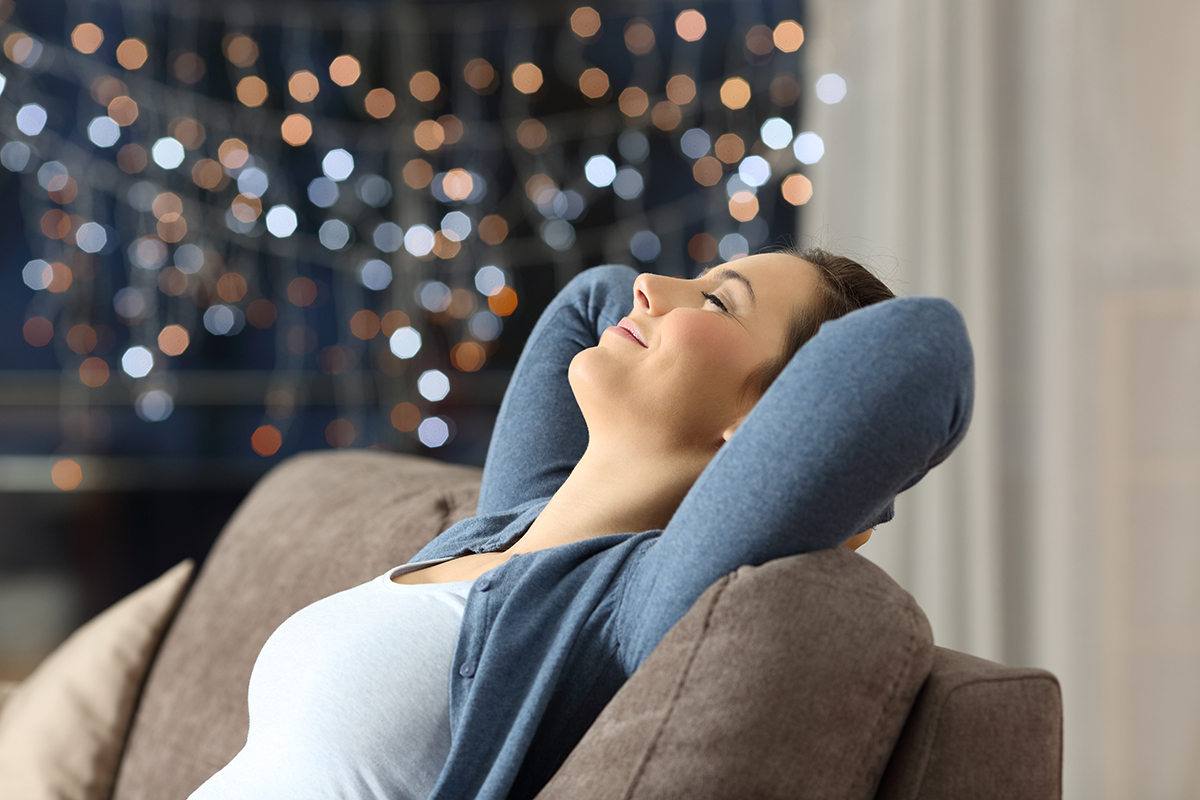
The New Dimension of Lighting
For a long time, the lighting industry had invested practically all of its resources in technologies, solutions and products that fulfill our visual needs. It was not until the discovery of a third photoreceptor (besides rods and cones) in the human eye and the evidence of the biological influence from light that the lighting community began to relate human health and well-being to light. The finding on non-visual effects of light since then has challenged the industry to take a more holistic approach that simultaneously takes into account both the visual and biological needs of humans. Human centric lighting (HCL) takes up this challenge and opens up a whole new world of opportunities with the advances in LED lighting and Internet of Things (IoT).What Is Human Centric Lighting
Human centric lighting is a lighting concept that puts the focus on bringing the dynamics of natural daylight back into people's everyday lives through biologically effective artificial lighting. HCL goes beyond the basic visual needs of people. It helps the human body to stay aligned with natural circadian rhythms that the human being has been conditioned throughout its history. Until 200 years ago, our ancestors spent 90% of their time in the sun and had their biological clocks synchronized to the 24-hour rhythm of the earth's ambient changes. Nowadays, people spend limited time outdoors during the day. And thus their exposure to natural daylight is drastically reduced. To make matters worse, inappropriate exposure to artificial light can lead to circadian disruption which is linked to increased incidence of disorders and diseases in modern society.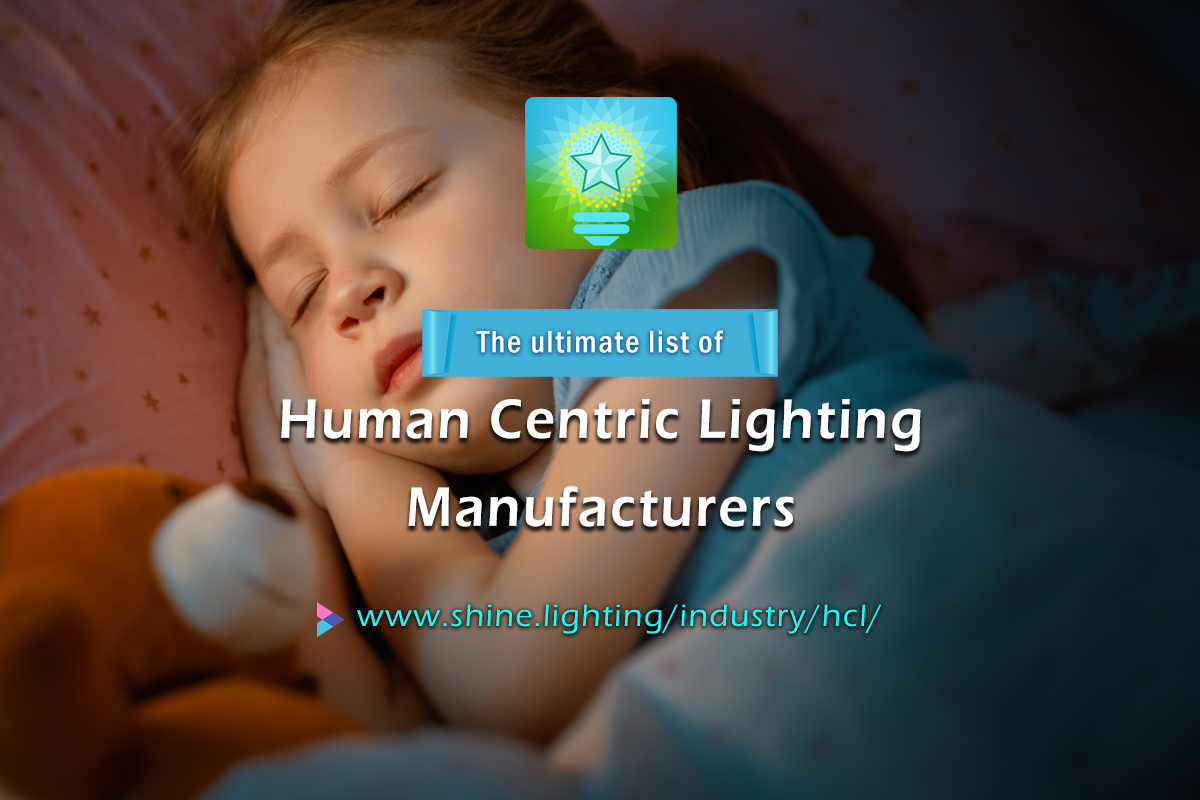
Rather than providing non-adaptive lighting with fixed optical radiation regardless of activity or time of day, human centric lighting simulates the dynamic changes in light intensity and color temperature of outdoor light over the course of the day. HCL provides biologically optimized compositions of light to enhance concentration and productivity in the daytime working and learning environments while encouraging relaxation and regeneration during the night. The holistic design of biologically effective lighting systems considers the effects of light exposure on both biological and emotional aspects of human physiology and at the same time provides visually comfortable and supportive illumination to address the functional needs.
The Biological Effects of Light
It was known that the visual sensation in humans is provided by two photoreceptors in the retina: rods and cones. The rod photoreceptor deals with low sensitivity, provides scotopic vision (night vision) and contributes to vision in the intermediate range (mesopic vision). The cone photoreceptor which responds to all colors in the visual spectrum contributes to vision in high light levels (photopic vision). At the beginning of this millennium, a third type of photoreceptors, the intrinsically photosensitive retinal ganglion cells (ipRGCs), in the eye was discovered. Also called photosensitive retinal ganglion cells (pRGCs), ipRGCs form the main neural conduit to the suprachiasmatic nuclei (SCN) within the hypothalamus region of the brain where our circadian clock is located.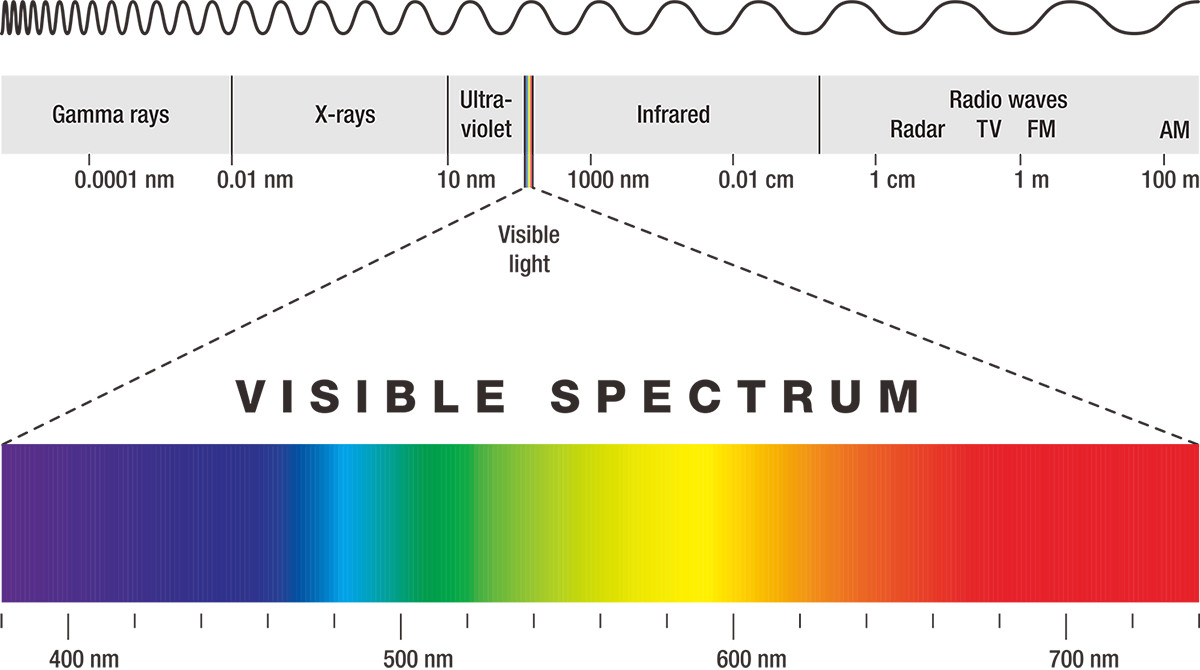
The ipRGCs participate in circadian phototransduction, a biochemical process in which the photoreceptor cells generate electrophysiological signals in response to captured photons. The SCN responds to neurological signals transmitted by the ipRGCs via the retino-hypothalamic tract (RHT) and regulates the secretion or suppression of hormones such as dopamine, cortisol, serotonin, and melatonin. In low light and under conditions of darkness, the pineal gland is triggered to produce the circadian neurohormone melatonin (N-acetyl5-methoxytryptamine) which leads to drowsiness and promotes sleep. When the eye senses optical radiation at a higher intensity, the release of melatonin will be suppressed and the production of dopamine, cortisol and serotonin will be triggered. Dopamine is an endogenous catecholamine that is needed for pleasure, alertness and muscle coordination. Cortisol is a stress hormone that promotes wakefulness and makes people feel alert and active. Serotonin is a neurotransmitter that provides impulse control, enhances mood and motivation.
The Power of Blue
The ipRGCs' photosensitivity is primarily driven by a photopigment called melanopsin. Melanopsin-deficient visual system can still help the human body to entrain to the light-dark cycle because the classical photoreceptors (i.e. rods and cones) also contribute to circadian phototransduction. The photobiological response is attenuated by approximately 40%, however. Melanopsin reacts only to short wavelength blue light and has peak photosensitivity at wavelengths primarily between 459 nm and 484 nm. When ocular light (light perceived with the eyes) with a high percentage of blue reaches these melanopsin-containing ipRGCs, the melanopsin receptors are activated and signal the SCN master circadian clock to cease the release of the sleep hormone melatonin while increasing secretion of dopamine, cortisol and serotonin to help the body to prepare for the day's activity. Continuous exposure to light with enriched blue during the day simulates a daytime physiological response, raises body temperature and heart rate, increase muscle strength and coordination, maximize alertness and productivity.
Circadian Disruption
The modern trend of people spending majority of their time indoors significantly increases the risk of circadian disruption as a consequence of improper exposure to artificial lighting. Offices, schools, commercial and industrial facilities utilize high intensity, blue-rich light to keep people more alert, concentrated, responsive and productive. Blue-rich light exposure is essential during the daytime to improve vitality and concentration, but it can be a health killer if this type of light exposure is extended into the nighttime hours. In fact, a large population often work or learn deep into the night. These people are at the high risk of circadian disruption because nighttime exposure to bioactive blue light acutely suppresses melatonin secretion and causes the body to reset the biological clock. Our biological clock has evolved to keep track of sunrise and sunset. The absence or very low level of bioactive blue light after sunset provides a night signal which tells the brain to produce melatonin. Melatonin secretion starts to climb around 9 P.M. and peaks around 2 A.M. The brain will cease melatonin production by 7 A.M. A change in the timing of melatonin secretion due to seasonal shifts, work night shifts or travelling across different time zones can also lead to circadian disruption. The SCN and peripheral clocks will have to readapt to new light-dark cycles.The Consequences of Disrupted Rhythms
Circadian disruption in modern society is typically resulted from suppression of melatonin secretion or changes in the timing of melatonin secretion. During the night, the release of melatonin allows for a regenerative sleep and refreshes our body. Melatonin is believed to internally synchronize the peripheral clocks to the SCN and carries photoperiodic information to distributed systems throughout our body. This hormone is directly and indirectly involved in the regulation of endocrine, neuronal, immunological, and behavioral processes. The pineal melatonin rhythm provides photoperiodic adjustments in immune defenses. Nighttime release of melatonin contributes a vital protective mechanism which suppresses the growth of cancer cells in the body. In addition to suppressed melatonin secretion, circadian disruption also negatively impacts the production of other hormones such as prolactin, parathyroid hormone, and thyroid stimulating hormone.Therefore, disruption of circadian rhythms can lead to a number of negative consequences. It is not just sleep that is affected, leading to fatigue, reduced daytime performance, and various sleep disorders such as insomnia and sleep apnea. The internal desynchronization between the SCN and the peripheral clocks affects our entire metabolism and cell proliferation. Disrupted circadian rhythms have been shown to be associated with obesity, diabetes, depression, bipolar disorders, cardiovascular disorders, reproductive problems, and seasonal affective disorders. Imbalanced hormone release can impair functioning of the immune system and impede the expression of clock genes related to cancers such as breast, prostate, and colorectal cancers.
The Importance of Understanding Color Temperatures
The term "color temperature" is a metric that quantifies the color appearance of a white light source. This term often interchanges with "correlated color temperature (CCT)", also strictly speaking CCT measures the color appearance of non-Planckian white light sources (e.g. fluorescent, HID, and LED lamps). CCT is expressed in kelvin (K). By way of example, a candle light has a typical color temperature of 1800 K, the color temperature at dusk and dawn is 2000 K or greater, an incandescent bulb has a typical color temperature of 2800 K, a halogen bulb has a typical color temperature of 3000 K, high angle sunlight at midday has a color temperature of about 5000 K, daylight on an overcast day is around 6500 K, and the color temperature of the blue sky is 9000 - 12000 K. The lower the color temperature is, the warm the light source appears because the light spectrum is saturated with red and orange wavelengths. The higher the color temperature is, the cooler the light source appears because the light spectrum is saturated with blue wavelengths. Therefore, light sources are generally classified as "cool white" (4000 K or greater), "neutral white" (around 3500 K), and "warm white" (3000 K or less). In the United States, color temperature that is 5000 K or greater is called daylight white.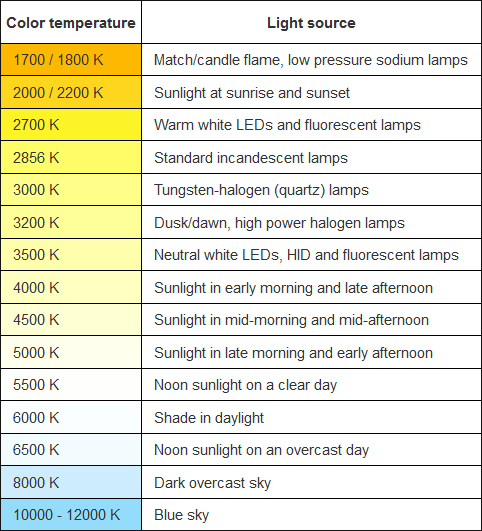
The previously mentioned terms "blue rich light" and "bioactive blue light" refer to white light with a cool cast (4000 K or greater). During the process of evolution, our circadian rhythm has been attuned to the natural sequence of day and night. The rising and setting of the sun form the natural boundaries between the working and resting time. From morning (e.g. 8 A.M.) to evening (e.g. 5 P.M.), the non-visual photoreceptor melanopsin in the eye reacts specifically to the blue components in outdoor light with sensitivity at its highest. The daylight with CCT in the 4000 - 6500 K range stimulates the biological organism to suppresses melatonin and enhance dopamine, serotonin, and cortisol production. It is during this period that people has the highest alertness, concentration, vitality, motivation and commitment to accomplish various tasks with high efficiency and productivity. Logically, cool white is the universal color temperature for artificial lighting in learning and working environments.
Warm, lower intensity light at sunrise and sunset gives people a soft start to the day or helps them wind down at night. The human circadian rhythm is inherently tied to the light cycle of the solar day and set to receive warm white light (2700 - 3000 K) that is stronger in the red part of the spectrum during the evening and night time. Melatonin in the absence of blue rich light rises at night, contributing to relaxation and promoting sleepiness. The warm tone of the light also imparts a feeling of comfort and coziness, and creates an intimate atmosphere that allows people to rest peacefully.
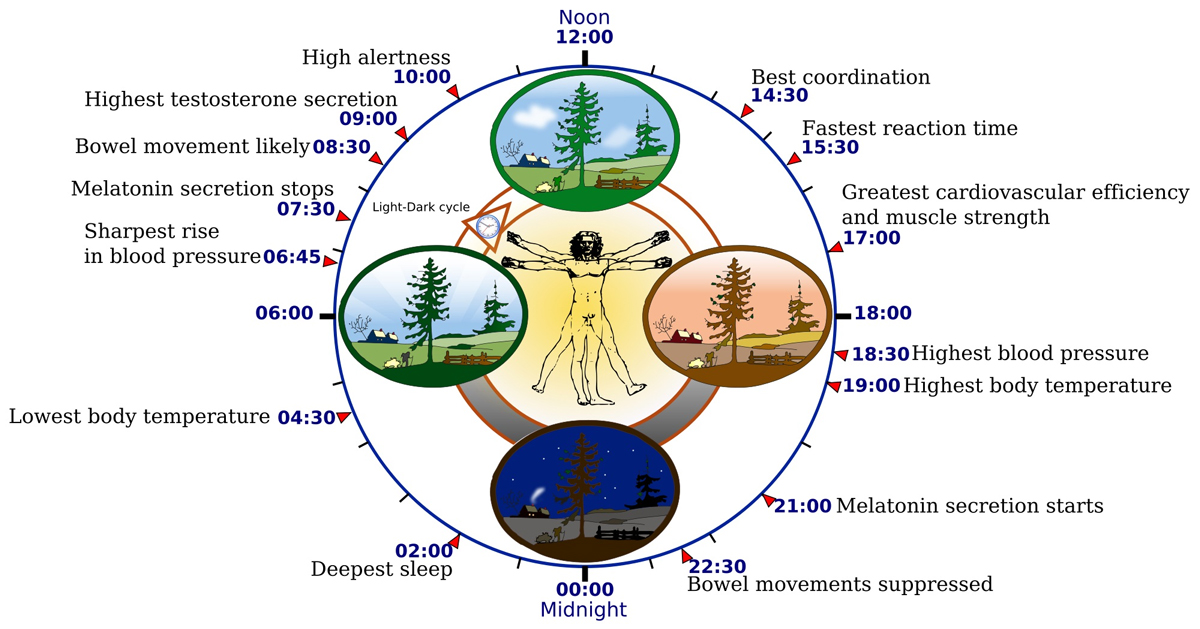
Rhythm of Life (Image courtesy of Yassine Mrabet)
The Convergence of Concept and Technology
Human centric lighting couldn't come at a better time. The invention of LED light sources was a huge breakthrough in the history of artificial lighting. The significance of LED technology doesn't merely lie in its high efficiency energy conversion. LED's impressive controllability that is comparable to other semiconductor devices offers tremendous opportunities to implement advanced features. Its programmable ability to dynamically specify light spectrum for a full range of color temperatures from very warm white light to daylight white light allows HCL lighting systems to replicate the color changes as the sun shines through different points in the atmosphere. Moreover, other HCL control components such as light intensity, timing and duration can be flexibly adapted to the human circadian rhythm. The marriage of LED and IoT brings human centric lighting to the next level. Connected HCL systems deliver data-driven intelligence on user behaviors for unprecedented automation.How Human Centric Lighting Works
Human centric lighting is implemented using tunable white LED lighting systems which are equipped with different types of LEDs, dimmable LED drivers, and controllers that run sophisticated calibration algorithms for CCTs in all the possible combinations. Tunable white technology is designed to provide variable color temperature controls and independent control of light intensity, thereby enabling the creation of ambiances, scenes and moods for alignment with a natural circadian rhythm.In most tunable white applications, the color temperature is infinitely adjusted along the Planckian curve from warm white to cool white light through color mixing of two different CCT LED loads (e.g. 2700 K and 6500 K). The control inputs for these fixtures can be 0-10V, CCR, PWM, DMX, or DALI control. The challenge of 2-channel CCT mixing is that color temperature must remain constant as intensity is adjusted and vice versa.
CCT tuning can also be achieved through RGB additive color mixing. The light engine of such a full color tunable lighting systems incorporates individually addressable and controllable LEDs in 3 channels (red, green, white) or 4 channels (e.g. RGBW, RGBA). This method not only allows independent control of intensity and CCT, but also enables adjustment of hue and vibrancy. Full color tunable lighting involves advanced controllers that synchronize digital control signals and regulate the current to individual LEDs.
HCL should not be equated with tunable white lighting. Tunable white is just a technology used in HCL systems to provide spectral and intensity tuning of the LEDs. The human aspect of HCL is the most important. Human centric lighting will inevitably integrate more intelligence and networking capabilities to support the trend towards IoT for the best possible experience. With the use of sensor technology, wireless communications, adaptive controls, and software applications, human centric smart lighting systems are environmentally aware and intuitively controllable. Integration with third-party building automation systems and web-based IoT services brings interoperability to HCL systems for vastly improved lighting control, user interaction, energy efficiency as well as automated lighting calibration with the 24-hour biological cycle.
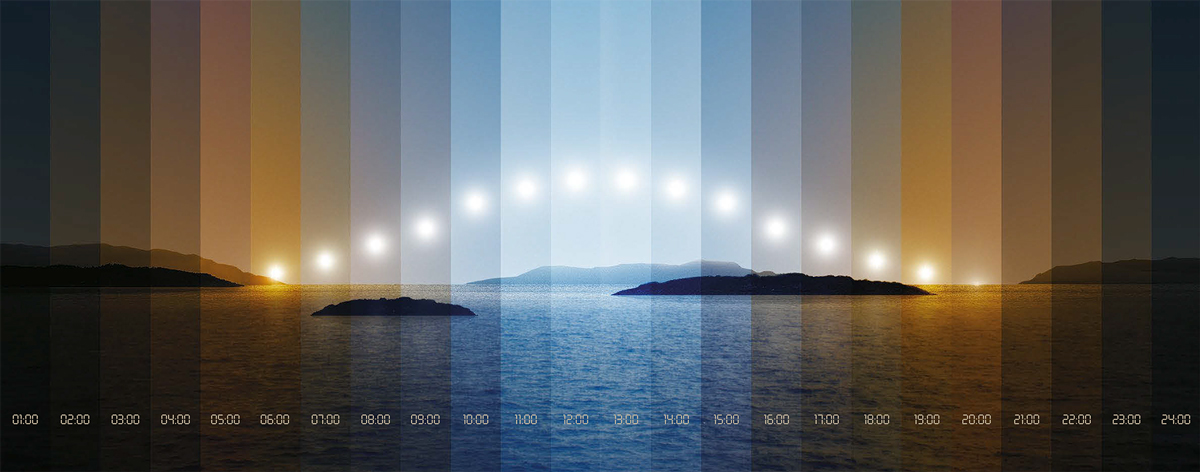
HCL Applications
Human centric lighting is devoted to mitigating physiological and psychological consequences resulted from the discrepancies between natural light and artificial light while also providing enhanced visual environments and improving people's performance. The concept of HCL is deemed to be an integral part of lighting design for all environments where people live, work and learn.Human centric lighting is making a difference in applications where people seek to heal disorders and conditions as a consequence of circadian disruptions, as well as in environments where an enhanced learning or working experience can be created with circadian lighting. Healthcare facilities have a clear need to implement HCL for creating a positive patient experience, promoting patient recovery, addressing patients' sleep issues, treating and/or preventing depressive symptoms. Because light with varying spectrums and intensities is found to support concentration, reduce fatigue and improve cognitive performance, education facilities are advantageously suited to deploy HCL systems that foster learning environments adapted to different activities. Other environments where circadian lighting can be applied include manufacturing facilities, office environments, and conference rooms. Although these places are flooded with blue-rich light to increase the motivation, commitment, and productivity of staff or workers, flexible adjustment of spectral composition and intensity of the light throughout the workday can improve employee satisfaction and performance.
It is worth mentioning that there is a large population in the world who has been exposed to high CCT artificial light (6000 K and above) from day to night. Excessively blue-rich light exposure for an exceedingly long duration not only disrupts their circadian rhythms but also renders them to photobiological risks (blue light hazard). People from this high risk group are in immediate need of circadian lighting.














